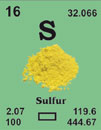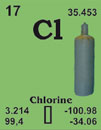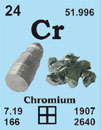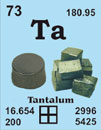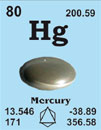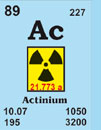Lithium 3Li6.939
Lithium was discovered in 1817 by J.A. Arfvedson at Stockholm, Sweden. Isolated in 1821 by W.T. Brande.
[Greek, lithos = stone]
French: lithium
German: lithium
Italian: litio
Spanish: litio
Description: Lithium is a soft, silvery-white metal that reacts slowly with oxygen and water. It is used in lightweight alloys, especially with aluminium and magnesium, and in greases, batteries, glass, medicine and nuclear bombs.
Lithium single crystal properties
| State: |
single crystal |
|---|
| Crystal structure: |
cubic, bc |
|---|
| Production method: |
Czochralski |
|---|
| Standard size: |
diameter 5mm
thickness 3mm |
|---|
| Orientation: |
(100), (110) and (111) |
|---|
| Orientation accuracy: |
<2°, <1°, <0.4° or <0.1° |
|---|
| Polishing: |
as cut |
|---|
| Roughness of surface: |
|
|---|
| Purity: |
99.8% |
|---|
| Typical analysis (ppm): |
C 3
H < 1
O 9
N < 5
Cu 1.60
Fe 1.80
Ni < 1
Pb 0.30
Si 0.30
Ga, Hf and Ta are below the detection limit
|
|---|
Materials properties
| Density: |
0.53 g/cm3 |
|---|
| Melting point: |
180.54 °C / 453.69 °K |
|---|
| Boiling point: |
1346.85 °C / 1620 °K |
|---|
| Molar volume: |
13.00 cm3 |
|---|
| Thermal conductivity: |
84.7 [300 K] Wm-1K-1 |
|---|
| Coefficient of linear thermal expansion: |
56 x 10-6 K-1 |
|---|
| Electrical resistivity: |
8.55x 10-8 [273 K] Wm |
|---|
| Mass magnetic susceptibility: |
+2.56 x 10-8(s) kg-1m3 |
|---|
| Young's modulus: |
4.91 GPa |
|---|
| Rigidity modulus: |
4.24 GPa |
|---|
| Bulk modulus: |
n.a. GPa |
|---|
| Poisson's ratio: |
0.36 |
|---|
| Radii: |
Li+ 78; atomic 152; covalent 123 |
|---|
| Electronegativity: |
0.98 (Pauling); 0.97 (Allred); 3.01 eV (absolute) |
|---|
| Effective nuclear charge: |
1.30 (Slater); 1.28 (Clementi); 1.55 (Froese-Fischer) |
|---|
| Number of Isotopes (incl. nuclear isomers): |
5 |
|---|
| Issotope mass range: |
5 -> 9 |
|---|
| Crystal structure, (cell dimentions / pm), space group |
cubic, bc |
|---|
| X-ray diffraction: mass absorption coefficients: |
CuKα 0.716 (µ/r) / cm2g-1
MoKα 0.217 (µ/r) / cm2g-1 |
|---|
| Neutron scattering length: |
- 0.190 b/10-12 cm |
|---|
| Thermal neutron capture cross-section: |
70.5 sa / barns |
|---|
Biological data
| Biological role: |
none, but lithium acts to stimulate metabolism and can control manic-depressive disorders |
|---|
| Toxicity |
|
|---|
| Toxic intake: |
20 - 200 g (see under hazards) |
|---|
| Lethal intake: |
LD50 (carbonate, oral, rat)=525 mg kg-1 |
|---|
| Hazards: |
Lithium is moderately toxic by ingestion but there are wide variations of tolerance. Even lithium carbonate, which is used in psychiatry, is prescribed at doses near to the toxic level. Some lithium c |
|---|
| Level in humans |
|
|---|
| Blood: |
0.004 mg dm-3 |
|---|
| Bone: |
1.3 p.p.m. |
|---|
| Liver: |
0.025 p.p.m. |
|---|
| Muscle: |
0.023 p.p.m. |
|---|
| Daily dietary intake: |
0.1 - 2 mg |
|---|
| Total mass of element in average [70 kg] person: |
7 mg |
|---|
Geological data
| Mineral | Formula | Density | Hardness | Crystal apperance |
|---|
| Amblygonite |
(Li, Na)AlPO4(F, OH) |
3.1 |
5.5 - 6 |
tric., vit./greasy white/grey |
|---|
| Lepidolite |
K(Li, Al)3(Si, Al)4O10(F, OH)2 |
2.85 |
2.5 - 3 |
mon., pink/lilac, lamellae |
|---|
| Petalite |
LiAlSi4O10 |
2.4 |
6 - 6.5 |
mon., vit./pearly colourless/white |
|---|
| Spudomene |
LiAlSi2O6 |
3.2 |
6.5 - 7.5 |
mon., vit. colourless/grey |
|---|
| Chief ore: |
petalite, lepidolite |
|---|
| World production: |
39000 tonnes/year |
|---|
| Main mining areas: |
USA, lithium is also recovered from brines of Searles Lake in California |
|---|
| Reserves: |
7.3 x 106 tonnes |
|---|
| Specimen: |
available as chunks, ingots, powder ribbon, rod, shot or wire. CARE ! |
|---|
| Abundances |
|
|---|
| Sun: |
10 (relative to H = 1 x 1012) |
|---|
| Earth's crust: |
20 p.p.m. |
|---|
| Seawater: |
|
|---|
| Residence time: |
|
|---|
| Classification: |
accumulating |
|---|
| Oxidation state: |
I |
|---|
Source: Emsley, J. (1998) The Elements (3rd Edition)

 English
English
 Deutsch
Deutsch
















